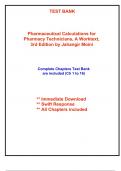TEST BANK
Pharmaceutical Calculations for
Pharmacy Technicians, A Worktext,
3rd Edition by Jahangir Moini
Complete Chapters Test Bank
are included (Ch 1 to 16)
** Immediate Download
** Swift Response
** All Chapters included
,Table of Contents are given below
Chapter 1. Fundamentals of Math
Chapter 2. Celsius and Fahrenheit Temperature Conversions
Chapter 3. Fractions and Decimals
Chapter 4. Ratios, Proportions, and Percentages
Chapter 5. Percentage of Errors Due to Equipment
Chapter 6. Ratio and Proportion Method
Chapter 7. Dimensional Analysis
Chapter 7. Dimensional Analysis
Chapter 8. Formula Method
Chapter 9. Concentrations
Chapter 10. Dilutions and Solutions
Chapter 11. Oral Medication Labels and Dosage Calculation
Chapter 12. Reconstitution of Powdered Drugs
Chapter 13. Parenteral Medication Labels and Dosage Calculation
Chapter 14. Intravenous Flow Rate Calculations
Chapter 15. Pediatric Drug Administration
Chapter 16. Business Math for Pharmacy Technicians
,The test bank is organized in reverse order, with the last chapter displayed first,
to ensure that all chapters are included in this document.
(Complete Chapters included Ch16-1)
Pharmaceutical Calculations for Pharmacy Technicians, 3 rd Edition
Chapter 16 – Business Math for Pharmacy Technicians
1. The marginal difference between actual cost and total reimbursement is referred to
as which of the following?
A. Expenses
B. Net profit
C. Markup
D. Gross profit
ANSWER: D
POINTS: 1
LEARNING OBJECTIVE: 1. Compute gross profit.
BLOOM’S LEVEL: Apply
FEEDBACK: The marginal difference between actual cost and total
reimbursement is referred to as gross profit. This is also known as gross margin.
2. The money left over after all overhead expenses are deducted from the gross
margin is called which of the following?
A. Net profit
B. Markup
C. Inventory turnover
D. Gross profit
ANSWER: A
POINTS: 1
LEARNING OBJECTIVE: 2. Explain net profit.
BLOOM’S LEVEL: Understand
FEEDBACK: The money left over after all overhead expenses are deducted from
the gross margin is the net profit. The net profit for each drug sold is calculated as
the difference between the overall cost and the selling price.
3. A pharmacy spent $1,150,000 on various items in its inventory last year. The
average inventory value during the past year was determined to be $215,000.
Which of the following was the turnover rate of the inventory?
A. 3.55
B. 4.22
C. 5.34
D. 6.25
ANSWER: C
POINTS: 2
, LEARNING OBJECTIVE: 3. Explain inventory turnover.
BLOOM’S LEVEL: Understand
FEEDBACK: The turnover rate of the inventory was 5.34. Turnover rate = total
purchases divided by average inventory. Therefore, 1,150,000/215,000 = 5.34
times.
4. A discount pharmacy has annual overhead expenses of $1,362,820. Its income is
$1,689,364. If the pharmacy is making a 15% profit, which of the following
amounts has to be received as income to meet the goal?
A. $1,287,153
B. $1,328,184
C. $1,567,253
D. $1,728,427
ANSWER: C
POINTS: 2
LEARNING OBJECTIVE: 2. Explain net profit.
BLOOM’S LEVEL: Understand
FEEDBACK: $1,567,253 has to be received as income to meet the goal. Overhead
× 0.15 = profit. So, $1,362,820 × 0.15 = $204,423. Because profit is equal to
incoming receipts minus overhead, then overhead + profit = income. So,
$1,362,820 + $204,423 = income, which is $1,567,253.
5. Which of the following is the best description of turnover?
A. The amount of revenue a product generates by the time it is dispensed and sold
B. The interest charge that the pharmacy pays for inventory purchased but not
used
C. The average amount of time the pharmacy retains a product before it is sold
D. The amount of time before a pharmaceutical expires
ANSWER: C
POINTS: 1
LEARNING OBJECTIVE: 3. Explain inventory turnover.
BLOOM’S LEVEL: Understand
FEEDBACK: Turnover is best described as the average amount of time the
pharmacy retains a product before it is sold. An inventory turnover rate is the
specific time period over which the total inventory is sold.
6. Which of the following is the gross profit for a pharmacy whose sales total
$299,543 and whose costs total $253,937?
A. $43,702
B. $46,606
C. $48,209




